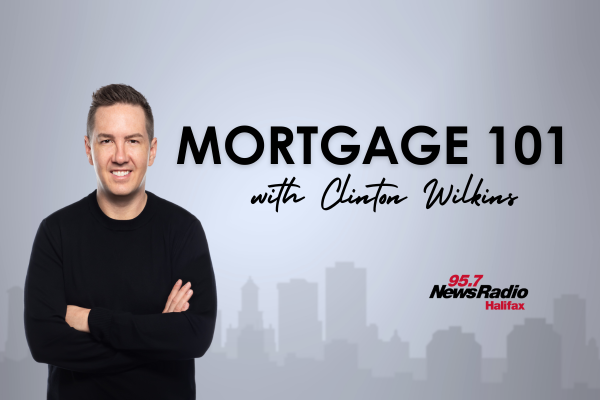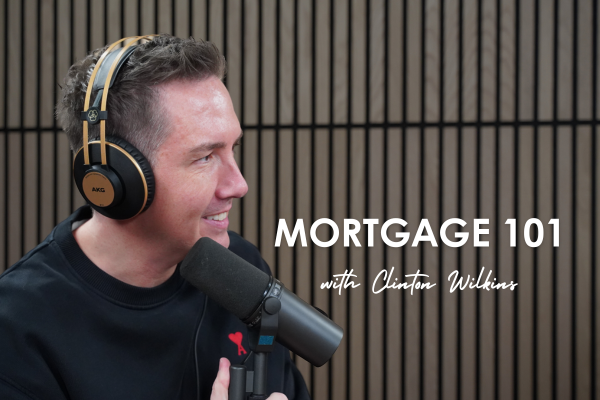Todd Veinotte and Clinton Wilkins discuss the evolving landscape of mortgage lending, highlighting its complexities and the importance of staying informed.

Mortgage 101 – What Goes Up, Must Come Down | May 29, 2023
In our latest segment of Mortgage 101, Clinton and Todd break down why people might take a variable, why it’s important to seek advice and not just consider the default, the current plateau we are in with rates, and uncertainty in the mortgage market.
Clinton Wilkins 00:00
And you know what? I love mortgage lending.
Todd Veinotte 00:01
Absolutely. And everybody has, has to love what you love.
Clinton Wilkins 00:05
And you know what you need to love what you do, and you don’t work a day in your life.
Todd Veinotte 00:10
If you love what you do, that’s true. This platitude brought to you by
Clinton Wilkins 00:14
Clinton Wilkins mortgage team, I don’t know or could be the Todd Veinotte show, you can listen to it, you know, Monday to Friday, City News.
Why take a variable rate?
Todd Veinotte 00:20
There you go. Nice plug. So when it comes to mortgage rates, what do you not do, Clinton?
Clinton Wilkins 00:25
What you need to not do is, you know, listen to your co worker, maybe listen to your parents. And, you know, just renew with your lender. Don’t do any of those things. Also 60% of Canadians take a five year fixed rate. I do not think that’s what you should do in every case. In some cases, yes that’s within your risk tolerance. Personally Todd? I think the rates are kind of high right now. RWhat is most popular, and I’m gonna let the secret out, most borrowers are doing like a three year fixed. Still, there’s a lot doing a five year fixed. And there’s still a lot doing variable. And I’ll tell you why. The people that are in the three year fixed, they think the rates are gonna go down, it gives enough time to kind of get through this hump, see where things are going to be. And they’re going to restructure at that point. We’re seeing some people doing a three year fixed transferring from one lender to another, leveraging them being a new customer and kind of getting a good rate. And we’re seeing some amortizations being extended, you know, to 25 years, not everyone, but some. Some borrowers are choosing to do a five year, there are some even lower rates, you know, the five year, four year are lower than the three year and shorter. And the reason that they’re doing that is they want to just set it and forget it. Certainly not for everyone and you need to know you should not break that mortgage, do not break it. Because if you break that you’re going to pay a big penalty, especially if the rates go down. And the reason why borrowers are taking a variable rate still Todd, you might ask me like why would they? The rates are higher. Why would I possibly take a variable? One reason, you might break your mortgage early, the penalty will be only three months interest. The other reason is you might convert into a fixed down the road, when the rates go down. You can convert from a variable into a fixed anytime. We’re not seeing a lot of borrowers doing a one year, and we’re not seeing a lot of borrowers do a two year because those rates are quite high, somewhere up to around like that 6% range. So if you’re going to do that, you might as well do a variable.
Todd Veinotte 02:33
So when would a one year be applicable for somebody?
Clinton Wilkins 02:36
If you know that you’re exactly like going to redo that mortgage in one year? But honestly, we’re doing very, very few one year fixed right now. Very, very few, like I can’t even remember the last one we did. And this is coming from the guy who always did a one year fixed for himself. Like, honestly.
Todd Veinotte 02:53
Why did you always do when one year fixed?
Clinton Wilkins 02:55
My life was so uncertain, I was buying, selling, trading. And typically, when you’re further along in your one year, you’re gonna get, you know, three months interest to break it. So like similar to a variable, I was either a variable or one year fixed guy. Right now, my mortgage, I am in a variable. So if that gives any solace to the listeners that are in a variable rate, you know, the mortgage professional who’s done $1.3 $1.4 billion worth of mortgages here and in Halifax and across, you know, really across the region is in a variable, you know, that should give you some solace. I do think that the rates are going to soften. I do think the Bank of Canada will, you know, soften the rates once we start getting into a recession type situation. And I also might break my mortgage, I will just put it out there. I am not sure what I’m doing with my life, I might keep the place I’m in. I might refinance it, or I might sell it. I don’t know. We’ll see. Right? What about having an open term? And open right now is 8, 9%.
Todd Veinotte 03:57
So what would be a – why?
Clinton Wilkins 03:59
You would do an open, if you think you’re going to break that mortgage in less than five months? Six months or less, we’ll say. If not, you should do a variable because the variable with the three months interest penalty is going to be cheaper than you paying that rate at that open term.
Five year fixed is the most common default
Todd Veinotte 04:15
Yeah, yeah, absolutely. Okay, so you mentioned I think you said it’s 60% of people take a five year fixed.
Clinton Wilkins 04:24
60% of Canadians take a five year fix.
Todd Veinotte 04:28
And do you feel that’s just kind of bank marketing? Or is that just people don’t think it through? It’s Okay, so you’re telling me that if you walk into a regular bank branch, and you sit down with somebody, they’re going to put a five year fixed in front of you.
Clinton Wilkins 04:32
It’s cultural. It’s the industry. It’s marketing. You know, us as Canadians, you know, a five year is just what you’re told. That’s the standard offering. You go and apply, a five year what you’re gonna get but you need to ask for something different or you need to shop around. And I specifically urge these borrowers that have a mortgage coming up for renewal this year. Please, please, please just don’t take what you’re given. Because there is a wide range of what is available out there in terms of pricing. And you know, when you come up for renewal, it’s a great time to look at your amortization, look at your equity, maybe change the type of product that you’re in. And, you know, the rates that are available between different lenders. Believe it or not, Todd, there is a big variety. It would shock you. It would shock you. That is the most normal rate, the most common.
Todd Veinotte 05:31
So they won’t have a conversation with you to say, okay we want to assess where you’re at and all of that, generally.
Seek advice and advocate for yourself
Clinton Wilkins 05:37
I’m not saying that every mortgage broker or every banker is the same. It’s the 80/20 rule, just like everything else, you know, 20% are doing 80%. And, but what about the other 80% of people, that are only doing a few. They’re gonna go to the default, they’re not going to know to ask you about what’s going on in your life. What is your plan? Are you staying in this house? Do you plan on breaking this mortgage early? Do you have any need to refinance? Do you have any need for funds, you know, in the next X number of years. Product, and, you know, set up and rate and rate product really make a big difference to your cost of borrowing, you know, over the life of your mortgage and I think you need to answer these key questions. And some of these questions I can’t answer for people, I can tell you right now, typically, what I do is I’m looking at everyone’s income assets and credit, I’m giving them three suggestions on what my recommendations are, I get to talk to clients every single day. So I can look at these different scenarios, I can very quickly, you know, look and say, okay this is what you have for equity. This is what your goals are, here are my recommendations, and then you noodle on it at home with you and your spouse, or you and on your own, and decide what’s going to work and then come back to me. This is why I get a lot of my documents up front so that I can give a very good recommendation. I know what’s going on with their assets, I know what’s going on with their income and their credit. And I can put that recommendation together.
Todd Veinotte 07:02
Alright, but I guess fundamentally, should that not be what your experience is as a consumer, when you walk in, as a client, when you walk into a bank?
Clinton Wilkins 07:10
It should be but not every employee is the same, just like not every mortgage broker is the same, not every bank is the same. So you know, you need to ask the questions, and you need to be an advocate for yourself, or you need to go to someone who’s going to be a strong advocate for you. And that’s why I’m such a, you know, a believer, and, you know, seeking the advice of an unbiased mortgage professional, and this show is not a, you need to call Clinton to do your mortgage show. This is a show to provide education. And hopefully, we’re educating consumers, I certainly get the feedback taught and I know you’ve received feedback too. People are listening, I was doing a tour of bank branches, we do a lot of mortgages with bank branches. Or with banks, I should say, and I don’t want to discount the banks, and I’m talking about all of the Big Five. They’re either in the broker channel, or they’re participating in the background in terms of funding some of these broker lenders. And I without saying their names, we deal with big green, and we deal with big red every day okay? And I was in some bank branches today, you know, I hadn’t been in branches for the last couple of years, you know, I need to get my face out there. They need to remember who I am obviously, you know, they can see me on a billboard, or listen to us on the radio. And the branch manager said to me, he’s like, I love Mortgage 101, I love the education that you’re doing with consumers. And they are coming in and asking us good questions. And, you know, it’s good for the industry. And I think it’s good for consumers. And that’s why for me, this is more of the education piece, I think, is what I love the most. And that’s why we’re able to keep this conversation going.
Rates will soften after a plateau
Todd Veinotte 08:44
Okay, so as far as the Bank of Canada, because people were glued to what the Bank of Canada has been doing, is that fever, kind of been dialed back a bit? Has that temperature been brought down a bit from the Bank of Canada and what they’re doing?
Clinton Wilkins 08:57
I mean, here’s the temperature, the temperature is on cruise control, right now we are in a plateau type situation. But what happens Todd after a plateau? Typically it goes back down, we were increase, increase, increase, now our plateau. And now we’re likely going to see the rates soften. When are they going to soften? Again, I don’t have a crystal ball. If I did, I wouldn’t be on the show. And consumers asked me, they’re like, okay, what’s gonna go on with pricing? If I set the price, you wouldn’t be talking to me? Because guess what, that’s way, way above my paygrade. But the one thing that I do do, I watch and I listen, and I research things that are economists are saying. I listen to things that the Bank Of Canada is putting out, and I put together my opinion. Which is an opinion. I am not an economist, but I can tell you after 17 years, I’ve seen a few of these cycles before. I remember when the prime rate was six and a quarter percent. I remember that. And then it went down to two and a quarter then it went back Back up, then I went back down. Yes, the rates are high today. But typically after a high period, there’s a plateau which we are currently in. Then after that, typically they soften again. So if history repeats itself, which it normally does, yes, that’s really what we’re going to start seeing.
Uncertainty in the mortgage market
Todd Veinotte 10:18
What type of timeframe do you think we’ll see? And do you think we’ll see numbers like 2%, numbers like that again, from the Bank of Canada?
Clinton Wilkins 10:26
There is a lot of uncertainty. First off, we didn’t think there’s gonna be a pandemic. We didn’t think that, you know, what was going on with Russia and Ukraine, or Ukraine and Russia was going to happen. And, you know, I think a good example is when some of these banks collapse in the US, okay? We saw an immediate dip in the bond markets in the costs, and then the rates went down and let me tell you, I repriced, probably 40 or 50 mortgages that hadn’t been funded yet, because we saw rates dip reprice, reprice, reprice. And it was able to reproduce commitments to our customers at a lower rate. But guess what, they’ve kind of come back up again, because that, you know, a little bit of a hangover from what happened at Silicon Valley Bank has now kind of re-stabilized. But the interesting thing, and I don’t know if you’ve read in the news, but last week, TD called off a big deal to buy a big American bank. The numbers were just not there. And the amount that they had to pay in terms of breakage fees for their deal was significant. But they made that choice to walk away from that deal, because they don’t want to put, you know, the Canadian bank in parallel. They don’t want to put their American bank in peril and the TD Bank Financial Group, they want to make sure that it’s still going to be healthy going forward.
Todd Veinotte 11:37
Yeah, we know the Canadian banking industry has always been a real beacon of strength globally, right?
Clinton Wilkins 11:41
You know, we have the most respected financial institutions in the world and a very strong regulatory and banking platform. And you know what, that’s for better or worse. Some people think that, you know, our banks are too rigid and too conservative and in some ways they are, but it protects us in the more challenging times, which we just went through.
Todd Veinotte 12:00
Yeah, thank goodness for that, eh?
Clinton Wilkins 12:01
Thank goodness, for sure.
Todd Veinotte 12:02
Absolutely, okay we got lots more to talk about. Mortgage 101, your guide to homeownership with Clinton Wilkins and myself, Todd Veinotte we’ll be right back.


